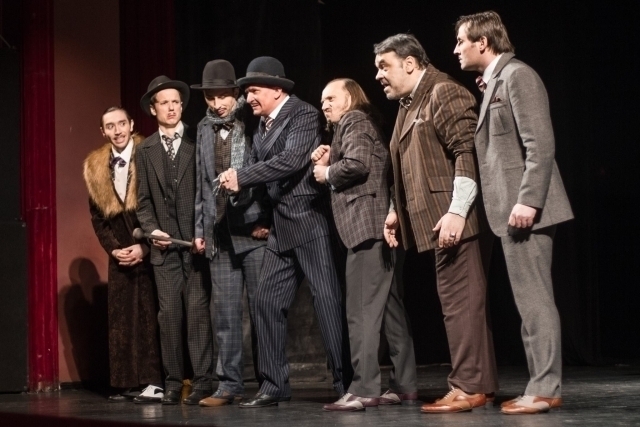Over January 19th and 27th, 2017, the ‘Mihai Eminescu’ National Theater
in Chisinau was on tour in Romania, as part of a project titled Romanian
Theater in Bucharest, Iasi and Chisinau. It was a project that took off at the
initiative of the National Theater in the Republic of Moldova, which in 2014
opened the season of the National Theater in Bucharest with its stage
performances. A week later, the Bucharest National Theater traveled to Chisinau
for a week of Romanian theatre in Moldova.
Such an exchange of tours has become
normal and even tradition, according to actor and stage director Petru Hadarca,
who is also the manager of the Mihai Eminescu National Theater:
It has enjoyed
and still enjoys success. The audience has its own expectations, in Chisinau as
well as in Bucharest. We usually arrive during the week when the Unification of
the Romanian Principalities is celebrated in Bucharest and Iasi. And for the
week when Bessarabia’s Unification with Romania is celebrated, on March 27, the
National Theater in Bucharest and the Vasile Alecsandri theater in Iasi come to
us. Theater doesn’t need borders. This is the Romanian theater of Bucharest -
Iasi – Chisinau. Plays are in Romanian. As Nichita Stanescu used to say ‘our
country is the Romanian language’.
The
‘Mihai Eminescu’ National Theater in Chisinau has presented in Bucharest
and Iasi three successful stage performances of its most recent productions.
One of the them is In Your Charming Eyes’, directed by Alexandu Vasilache,
after short stories by Gib Mihaescu (1894 – 1953), who used to be a member of
the artistic committee of the National Theater in Chisinau. The other two premieres
brought on tour in Romania are Anything to Declare? by Georges Feydeau,
directed by Petru Hadârcă and The Big House
by Ion Druţă, directed by Alexandru Cozub.
The actors of the
National Theater in Chisinau perform only in Romanian and their repertoire
comprises various pieces of world drama. With details on that, here is stage
director Petru Hadârcă again:
We try to
tackle mostly topics related to us, to Chisinau and Bessarabia. Since it is a
national theater, 80 per cent of the plays are part of the national drama
rapertoire. We try to cater for the taste of various categories of audience. We
also have a show created by the theater’s young actors, on a tough, dramatic
topic in our people’s history, based on the testimonies collected by Alexei
Vakulovski, ‘Children of the famine’.
It is a stage performance dealing with the famine of 1946-1947, during the
communist regime, when around 500 thousand Bessarabians died. And this is a
painful thing, by all means. And I take a look at our audience. There are
people in the audience who have gone through that experience. They were
children back then. And they come to watch the play with a lot of interest. It
is a memory exercise. I have to say that the audience in Chisinau is really
special, we love them just as much as they love us. Unfortunately, there are
people in our society that make a spectacle of themselves in Parliament, on
television. We laugh and say that they are those who are acting, while, we on
stage, are just being natural.
During the tour in
Bucharest, Petru Hadarca also held a conference titled Documents, an invincible
power against historical speculations. Two volumes were launched at the
conference, comprising documents about the history of the Chisinau theatre,
gathered from the Bucharest National Archives and the library of the Romanian
Academy. They are titled The Genesis of the National Theatre in Chisinau:
1918-1960 by Iurie Colesnic, and A Chronicle of the Mihai Eminescu National
Theatre in Chisinau: 1818-1930, a volume edited by actor and director Petru
Hadarca., the general manager of the Mihai Eminescu National Theatre.
Here is
Petru Hadarca himself:
Each time I
think about those documents, I feel joyful like a child, because I discovered
in the archives the deed for the setting up of the National Theatre in October
1921, bearing the header and the stamp of the of the National Theatre in
Chisinau. It’s great! Because, in the Soviet period, historians used to say the
building hosting the theater had been erected by two Soviet architects between
1953-1954. But the documents that we have found tell a different story. In
1930, the theatre was already up, designed just like the Athenaeum in
Bucharest. They speak of successes different from what they were in the
interwar period, things that were taboo before 1990 and even after. Now that these
books have been published, a certain part of the press has already started to
attack us, to contest us and impose their own point of view, because there are
still many people who choose to forget real history and remember only what they
want. What I have gathered in these books makes me feel proud and I can say
that the National Theatre has had a very beautiful history. It’s for the first
time this year that I’ve said how many seasons there have been, because we
didn’t know before. So, for the first time I said ‘This is the 95th
season of the theatre’ .
The Mihai Eminescu
theatre in Chisinau has two halls: the Big Hall, with 400 seats, and the Studio
Hall, with 100 seats. Although it is a national theatre, only 80 % of the
budget comes from the state, the rest being covered by money obtained from
selling tickets and private funding.
